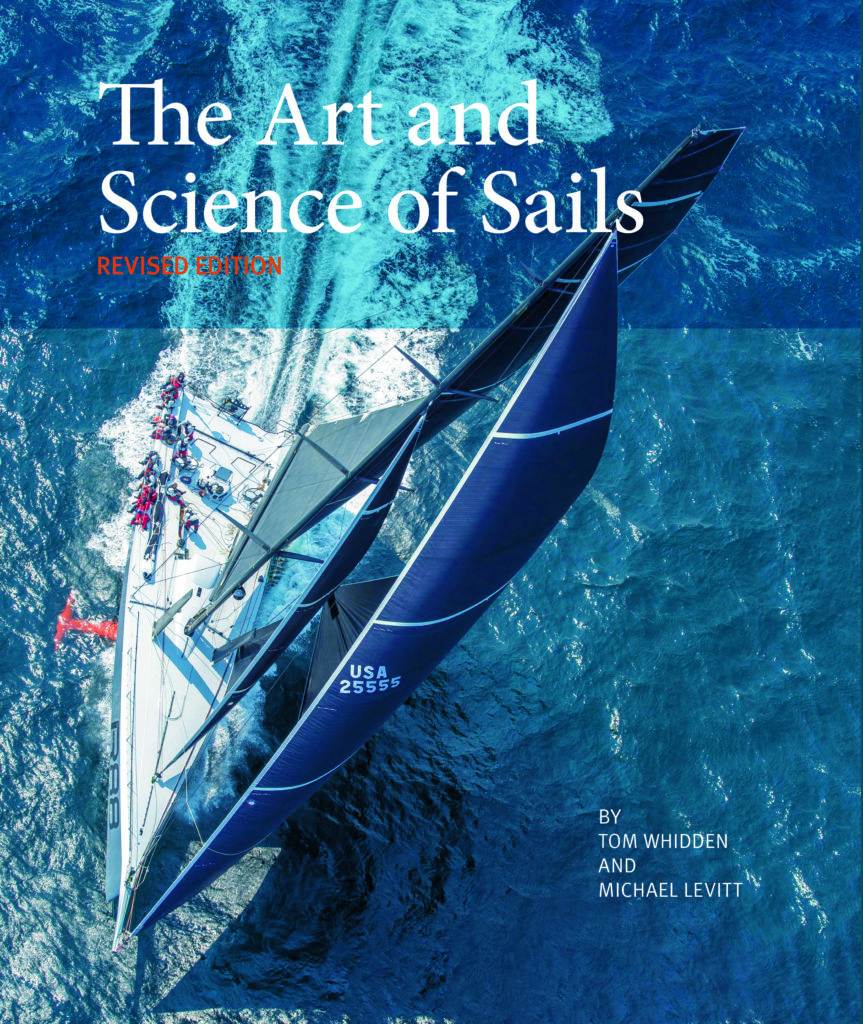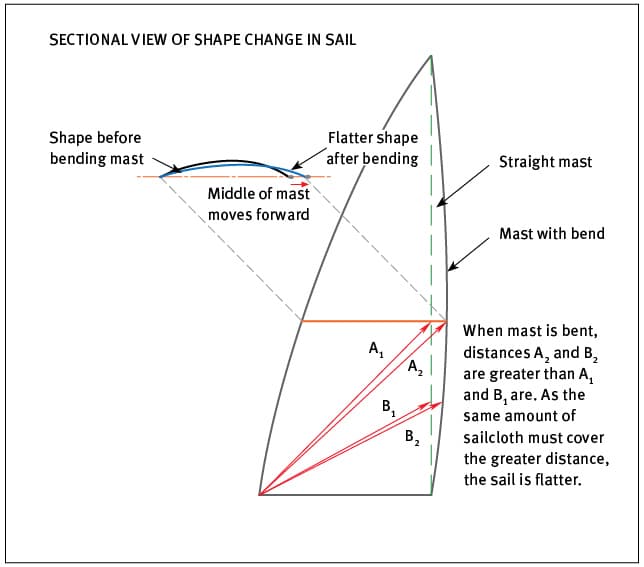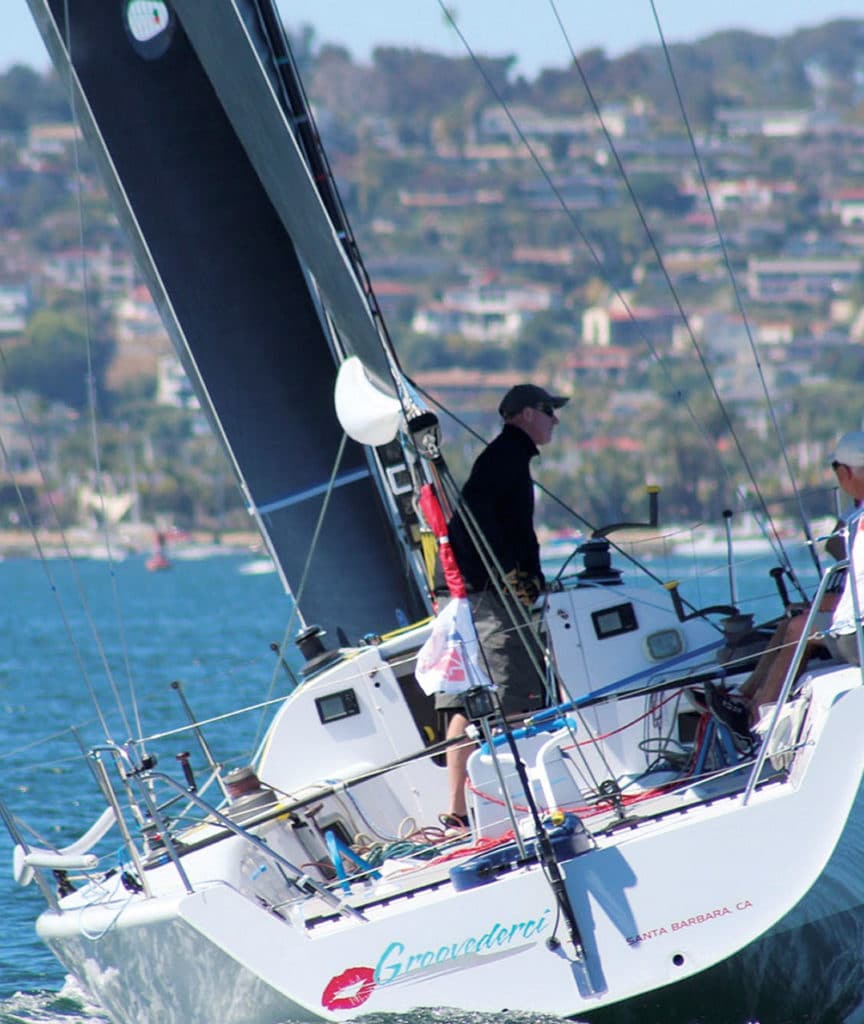
Even more significant for the optimization of upwind speed is twist: the vertical shape of the leech. It’s been said that the only reason to have a front of a main is to be able to attach the leech area to the mast! In the headsail chapter, we will learn that on most boats while sailing upwind, the headsail trimmer is limited or guided by the position of the spreaders. The leech of the main, however, is hanging out in space, with no reference except leech telltales. Its role is not just to ensure that the air bent around the front of the main is allowed to exit with the least interference (induced drag), but to help steer the boat. For these two reasons, main trim has a greater effect on a boat’s performance than does that of the headsail.
So, how should the trimmer adjust the leech to best attain the above two goals while sailing upwind? With a well-designed and relatively new main, the answer is to sheet the main until the top telltale (preferably hanging off the back of the top batten) just begins to stall. If it’s constantly stalled (hidden to leeward), it’s a sign drag is too high. The lift-to-drag (L/D) ratio is lowered. If the telltale is flying straight back or there is an excess of backwind, it’s a sign that the sail could be sheeted tighter to allow the boat to sail closer to the wind. In this case, the L/D ratio is reduced for the opposite reason. However, to understand the dynamics here, we need to focus on the function of balance.
Every sailboat has two balance points, called centers of effort (CE). The hydro CE is below the water; the aero CE is above the water. The hydro CE — sometimes called center of lateral resistance, or CLR — is influenced primarily by the keel and rudder size and position, along with the hull shape below the waterline. The aero balance is a function of the sail plan, its fore-and-aft position on the boat, sail sizes, aspect ratios, and even shapes.
A goal of the yacht designer is to determine the optimum balance of these two CEs prior to launch. It’s no fun to have to move a mast, keel, or rudder, although many high-tech projects in the past have done exactly that. It’s another reason why computer simulation is so critical, and why North Sails has been invited to work with yacht designers in the early stages of the design process of most high-tech racing boats. Yacht designers have good tools and experience for predicting the underwater CE, but it’s not uncommon for them to rely on sail designers for an accurate aero CE.
The measure of balance of the two CEs is rudder angle. Rudder angle is the compensating factor for yaw: the tendency of a boat to rotate around its vertical axis. Depending on the boat, three to five degrees of windward rudder angle is optimum. In this case, the boat would exhibit “weather helm.” The reason is that, with the rudder aimed to windward—in order to counter the natural and desirable tendency for the sailboat to turn up into the wind to then allow the boat to sail to its course—the lift-to-drag ratio of the rudder increases. It’s why a main trimmer will often say to a less-experienced helmsman, “Never steer up.” However, an experienced trimmer will never have to say it. He or she will do most of the steering.

How It Works
Let’s assume the sailboat is sailing upwind in 12 knots true wind speed (TWS) with an ideal three degrees of windward rudder angle. Suddenly, a puff to 15 TWS hits, without any change in true wind direction (TWD). This is called a velocity lift. The following occurs: the load on the sails increases, the boat heels more and its speed increases. Because the TWS increases, the apparent wind angle (AWA) will widen. Because the widening effect on AWA is immediate, the main will automatically be over-sheeted. As the effect of heeling begins to assert itself, the helmsman has no choice but to steer down, which increases rudder angle beyond the optimum. The result is a reduction in the lift-to-drag ratio above and below the waterline.
Now imagine the opposite. A lull, with a constant TWD, causes the boat to sit more upright, meaning it wants to fall away from the wind. Here, the AWA suddenly narrows, causing both the main and headsail to luff. We say that angle of incidence is too narrow. Recall that when that happens to a plane, lift decreases and drag increases—meaning it could drop from the sky. A boat slows. In both cases it’s because lift decreased relative to drag. Now, the helmsman has to steer up. Best case is a narrower rudder angle and lower lift relative to drag. Worse case is the rudder is actually pointing to leeward. The boat will be out of balance, with the direct result being a loss of VMG, caused by increased leeway and less lift from the sail plan and rudder.

All is cured with mainsail trim, with the trimmer using the main’s leech as the primary “rudder.” In the first instance, if the trimmer anticipates the increased pressure, the sheet or traveler or both will be eased; the leech will twist open; the heel will stay constant; and the sailboat will remain in balance. In the lull, the leech is sheeted in, which moves the aero CE aft, which relatively pivots the boat to weather; this reduces or eliminates the need for the helmsman to steer down.
In summary, if the main trimmer is doing his or her job upwind, the helmsman will not have to steer at all. At least, that’s the goal.
With this understanding, it should be clearer now why leech control far surpasses any other mainsail-shape control in importance. On a relative basis, the two least important controls are cunningham and outhaul. The cunningham, exerting tension on the luff of the main, is really only used to remove the wrinkles, given the low-stretch materials generally used today. Most outhauls on racing boats are maxed above 12 TWS, all to minimize form drag. That extra depth is needed only for light-air upwind and all other points of sail until heel force becomes a factor.
Traveler height is a more important control, only because it allows the trimmer to position the overall leech, with a given twist, in the optimum position. Note that the traveler does not affect leech shape. The sheet does that and, to a lesser extent, so does mast bend. However, a straight athwartships traveler will exert down pressure on the boom at the extremes. It’s why some travelers should be curved.
On most modern race boats, in light to medium conditions of 6 to 12 TWS, the boom wants to be positioned slightly above centerline, particularly in flat water. This is to push the aero CE even further aft to load up the rudder, all to create the optimum rudder angle. Until the boat is overpowered, the boom should remain on the centerline. In heavy air, some trimmers set the boom in the center and play the sheet, while others will set the sheet and play the traveler. Typically, the former is better, only because it’s faster.
In heavy air upwind, some trimmers use the boom vang — normally used only going downwind — to both bend the bottom of the mast to remove curvature and prevent too much leech twist when the sheet is eased in the puffs. And in really big breeze, experienced main trimmers sail the boat “on the leech”; that is, they allow the front half of the main to flog. It’s functioning as a rudder, not creating much lift; that’s the primary job for the main in this condition.
Reaching and downwind trimming is comparatively easy. One only needs to ease the sheet until the forward edge luffs and then trim slightly. An eased-off cunningham and loose outhaul are obviously beneficial, until the boat is overpowered.
Aside from sheet tension, what’s critical in off-the-wind sailing, particularly VMG sailing, is vang tension. Anyone who has sailed competitive one designs will know this. With too much vang, induced drag becomes the overriding factor from too tight a top leech. With too little vang, desired force (pressure drag) is reduced. Therefore, the vang should be adjusted almost as much as the sheet in varying conditions.









